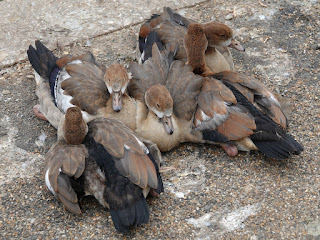After months of absence, the Peregrines were back on the tower of the Knightsbridge barracks. There was a brisk wind and they were perched some way back from the edge of their ledge, so I had to photograph them from a distance.
The female Little Owl near the Round Pond was up against the trunk of her tree sheltering from the wind, which blasts over this exposed place.
She seemed restless, so I started filming her. And then she picked up a leaf and started biting it and playing with it. I've never seen an owl playing before.
The female owl at the Serpentine Gallery was less bothered by the wind, as the surrounding trees give shelter. She was out on a branch.
A family of Blue Tits jumped around in a bush in the Flower Walk. The young ones are still grey rather than blue.
This duckboard in the Italian Garden fountain pool is a place where Feral Pigeons like to bathe. It's lost the wooden crossbars that were supposed to provide steps for ducks, and the pigeons can't help sliding down it, often colliding with the one at the bottom.
The young Carrion Crows have seen their parents opening peanuts with a few skilful pecks. This one tried to do it but failed, so it went over to its parent and begged.
The young Grey Herons were preening in their nest.
A pair of Moorhens had a conversation on the edge of the Serpentine.
The dominant Mute Swans on the Long Water brought their two cygnets over to Peter Pan. The young ones are quite large now.
The five Egyptian goslings are teenagers now but still like to huddle together in a sociable heap.
The single Mallard duckling is still on the Serpentine and has grown noticeably, but it's still in constant danger.
There was also a Red-Crested Pochard drake in eclipse.
Mark Williams sent two interesting pictures. I think this butterfly in St James's Park is a Silver-Washed Fritillary, but I'm far from sure. Update: confirmed by no less a person than John Ferguson.
Red Soldier Beetles mated on a stem at the Welsh Harp reservoir.
Common Wasps may nest in a papier-mâché structure built in a tree, or in a hole in the ground. Here is a nest of the second type. It's a remarkably large hole for such a small creature to dig.
White-Tailed and Buff-Tailed Bumblebees are often tricky to tell apart, but a bee that has both a white tail and bright yellow stripes can be assumed to be the former. This one was on a globe thistle.
It flew to another flower and joined a Honeybee. Here in shadow I'd have said it was Buff-Tailed, but it was the same bee.










%202022%201a.jpg)
%202022%201a.jpg)


What extraordinary behaviour! I wonder if she was self-soothing because she was feeling restless.
ReplyDeleteGlad to see the cygnets are looking so healthy. They're going to be as big as their father.
I wonder what a Moorhen conversation would be like. Crow chats are easy to imagine, but what would a Moorhen have to say to another Moorhen?
Tinúviel
I think the one on the left was refuting the Arian heresy. It just had that look.
DeleteLovely Little Owl portraits & fun watching the pigeon slide.
ReplyDeleteThe Silver-washed Fritillary is a male & the hot weather seems to have resulted in some good dispersal. The nearest colony to me is in Ruislip Woods but Sunday before last I saw one (& amazingly also a Dark Green Fritillary) at Yeading Brook meadows-my first for both in over 15 years of regular visits. The following day one also turned up in my garden-totally off the radar!
Interestingly a Silver-washed Fritillary was also filmed not too far from you (there's a video on the Herts & Middx Butterfly Conservation web site) a couple of weeks back in a garden near Green Park.
So there's a chance we might see one here. Will keep an eye out.
DeleteIn Bromley in May a pair of peregrines turned up bred and left - I wonder if they are the same ones as the Hyde Parks one? Sadly I didn't get any photos
ReplyDeleteWhether or not the pair is the same, it does seem likely that our Peregrines have been away breeding.
Delete